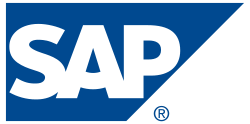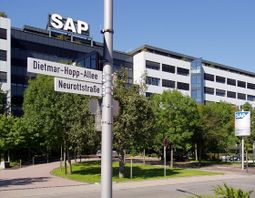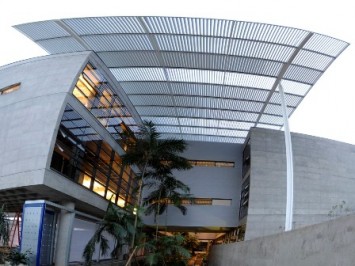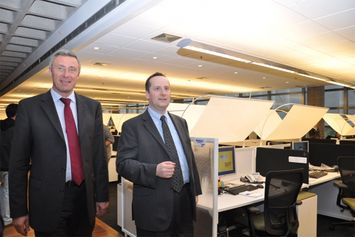SAP AG
 |
|
| Type | Aktiengesellschaft ISIN: DE0007164600 FWB: SAP NYSE: SAP |
|---|---|
| Industry | Computer software |
| Founded | Weinheim, Germany (1972) |
| Founder(s) | Dietmar Hopp Hans-Werner Hector Hasso Plattner Klaus E. Tschira Claus Wellenreuther |
| Headquarters | Walldorf, Germany |
| Area served | Worldwide |
| Key people | Bill McDermott (Co-CEO, Global Field Operations) Jim Hagemann Snabe (Co-CEO, Business Solutions & Technology) Gerhard Oswald (COO) Werner Brandt (Finance & Administration) Hasso Plattner (Chairman of the supervisory board) |
| Products | SAP Business Suite SAP ERP SAP CRM SAP SCM SAP SRM SAP PLM SAP NetWeaver SAP Business One SAP Business ByDesign SAP Business All-in-One SAP Business Objects Suite List of SAP products |
| Revenue | |
| Operating income | |
| Profit | |
| Total assets | |
| Total equity | |
| Employees | 47,578 in over 50 countries (December 31, 2009)[1] |
| Website | SAP.com |
SAP AG (ISIN: DE0007164600, FWB: SAP, NYSE: SAP) is a German software development and consulting corporation, which provides enterprise software applications and support to businesses of all sizes globally. Headquartered in Walldorf, Germany, with regional offices around the world, SAP is the largest software enterprise in Europe and the fourth largest software enterprise in the world as of 2009.[2] The company's best known product is its SAP Enterprise Resource Planning (SAP ERP) software.
Contents |
History
SAP was founded in 1972 as System Analyse and Programmentwicklung ("System Analysis & Program development in Data Processing")[3] by five former IBM engineers in Mannheim, Baden-Württemberg (Dietmar Hopp, Hans-Werner Hector, Hasso Plattner, Klaus Tschira, and Claus Wellenreuther).[4]
As part of the Xerox exit strategy from the computer industry, Xerox retained IBM to migrate their business systems to IBM technology. As part of IBM's compensation for the migration, IBM acquired the SDS/SAPE software, reportedly for a contract credit of $80,000. The SAPE software was given by IBM to the founding ex-IBM employees in exchange for founding stock provided to IBM, reportedly 8%. Imperial Chemical Industries (ICI) was SAP's first ever customer in 1972.[5]
The acronym was later changed to stand for Systeme, Anwendungen und Produkte in der Datenverarbeitung ("Systems, Applications and Products in Data Processing").
In 1976, "SAP GmbH" was founded and the following year, it moved its headquarters to Walldorf. SAP AG became the company's official name after the 2005 annual general meeting (AG is short for Aktiengesellschaft).
In August 1988, SAP GmbH transferred into SAP AG (a corporation by German law), and public trading started November 4. Shares are listed on the Frankfurt and Stuttgart stock exchanges.[4]
In 1995, SAP was included in the German stock index DAX. On 22 September 2003, SAP was included in the Dow Jones STOXX 50.[6] In 1991, Prof. Dr. Henning Kagermann joined the board; Dr. Peter Zencke became a board member in 1993.[7] Claus Heinrich,[8] and Gerhard Oswald [9] have been members of the SAP Executive Board since 1996. Two years later, in 1998, the first change at the helm took place. Dietmar Hopp and Klaus Tschira moved to the supervisory board and Dietmar Hopp was appointed Chairman of the supervisory board. Henning Kagermann was appointed as Co-Chairman and CEO of SAP next to Hasso Plattner. Werner Brandt joined SAP in 2001 as a member of the SAP Executive Board and Chief Financial Officer.[10] Léo Apotheker was a member of the SAP Executive Board and president of Global Customer Solutions & Operations from 2002, and was appointed Deputy CEO in 2007. Apotheker became co-CEO alongside Kagermann in 2008.
Henning Kagermann became the sole CEO of SAP in 2003.[11] In February 2007, his contract was extended until 2009. After continuous disputes over the responsibility of the development organization, Shai Agassi, a member of the executive board who had been named as a potential successor to Kagermann, left the organization.[12] In April 2008, along with the announcement of Apotheker as co-CEO, the SAP supervisory board also appointed three new members to the SAP Executive Board, effective 1 July 2008: Corporate Officers Erwin Gunst, Bill McDermott, and Jim Hagemann Snabe.[13]. With the retirement of Kagermann in May 2009, Apotheker took over as the sole CEO. He was replaced by new co-CEOs Bill McDermott, head of field organization, and Jim Hagemann Snabe, head of product development, effective February 7, 2010
Milestones in Technical Solutions
In 1973, the SAP R/1 solution was launched.[14] Six years later, in 1979, SAP launched SAP R/2.[14] In 1981, SAP brought a completely re-designed solution to market. However, it wasn't until 1985-1990 did SAP monumentally improve. The most major improvements weren't created by the five SAP founders, nor their few employees, for it wasn't until SAP partnered an unlikely educational institute did it have the progressive intellect and manpower needed to take the ERP to new heights.
In 1985, four years after SAP R/2 emerged, SAP had big plans, but few resources needed to improve upon their ERP. At the same time, nearly 9000Km (5600Mi) at the California State University at Chico (CSUC), kindly referred to as "Chico State" a Grad Student attending classes in the precursor of the College of Business at Chico State had a few big plans of his own. The Grad Student informed a couple of the senior professors about this new ERP tool called "SAP" and wondered if they might contact SAP and obtain an evaluation copy to use in the Database Mgmt. and/or the Production Mgmt. classes. Chico State professors contacted SAP and soon the conversation went from "evaluation" to "development". Needless to say, both sides jumped at the opportunity to become partners.
Chico State remained SAP's only educational partner for the first few years vastly improving and extending modules within R/2 leading to the development of R/3 with a few new modules. SAP and Chico State developed and released several versions of R/3 in 1992 thru 1995. By the mid 1990's, SAP followed the trend from mainframe computing to client-server architectures. The development of SAP’s internet strategy with mySAP.com redesigned the concept of business processes (integration via Internet).[4] SAP was awarded Industry Week’s Best Managed Companies in 1999.[15] By 1997, SAP had partnered with over 25 educational institutes, including the most prestigious of them all: Michigan Institute of Technology (MIT).
Business and markets

SAP is the world's largest business software company and the third-largest independent software provider in terms of revenues (as of 2007).[16] It operates in three geographic regions – EMEA, which represents Europe, Middle East and Africa; the Americas (SAP America, headquartered in Newtown Square, Pennsylvania), which represents both North America and Latin America; and Asia Pacific Japan (APJ), which represents Japan, Australia, India and parts of Asia. In addition, SAP operates a network of 115 subsidiaries, and has R&D facilities around the globe in Germany, Turkey, Canada, China, Hungary, India, Israel, Bulgaria, and North America.
SAP focuses on six industry sectors: process industries, discrete industries, consumer industries, service industries, financial services, and public services.[17] It offers more than 25 industry solution portfolios for large enterprises[18] and more than 550 micro-vertical solutions for midsize companies and small businesses.[19]
SAP and Enterprise Service-Oriented Architecture
Service-oriented architecture moves the ERP (Enterprise Resource Planning) landscape toward software-based and web services-based business activities. This move increases adaptability, flexibility, openness and efficiency. The move towards E-SOA helps companies reuse software components and not have to rely as much on in-house ERP hardware technologies which helps make ERP adoption more attractive for small- or mid-sized companies.
According to a press fact sheet from SAP, "SAP is the only enterprise applications software vendor that is both building service-orientation directly into its solutions and providing a technology platform SAP NetWeaver and guidance to support companies in the development of their own service-oriented architectures spanning both SAP and non-SAP solutions." [20]
SAP E-SOA Authentication
SAP E-SOA, client certificate-based authentication is the only authentication method (besides username/password) and the only Single Sign-On method to be supported across all SAP technologies. Kerberos and logon tickets, for example, are not compatible with SAP service-oriented architecture.[21]
Products
SAP's products focus on Enterprise Resource Planning (ERP). The company's main product is SAP ECC. The current version is SAP ECC 6.0 and is part of the SAP Business Suite. Its previous name was R/3. The "R" of SAP R/3 stood for realtime - even though it is not a realtime solution. The number 3 related to the 3-tier architecture: database, application server and client (SAPgui). R/2, which ran on a Mainframe architecture, was the predecessor of R/3. Before R/2 came System RF, later dubbed R/1.
SAP ECC is one of five enterprise applications in SAP's Business Suite. The other four applications are:
- customer relationship management (CRM) - helps companies acquire and retain customers, gain marketing and customer insight
- product lifecycle management (PLM) - helps manufacturers with product-related information
- supply chain management (SCM) - helps companies with the process of resourcing its manufacturing and service processes
- supplier relationship management (SRM) - enables companies to procure from suppliers
Other major product offerings include: the NetWeaver platform, Governance, Risk and Compliance (GRC) solutions, Duet (joint offering with Microsoft), Performance Management solutions and RFID. SAP offers SOA capabilities (calling it Enterprise SOA) in the form of web services that are wrapped around its applications.
While its original products were typically used by Fortune 500 companies, SAP is now also actively targeting small and medium sized enterprises (SME) with its SAP Business One and SAP Business All-in-One.
On 19 September 2007 SAP announced a new product named SAP Business ByDesign. SAP Business ByDesign is a Software as a Service (SaaS) offering, and provides a fully integrated Enterprise Resource Planning (ERP) solution, On Demand. SAP Business ByDesign was previously known under the code name "A1S".[22] In October 2007 SAP AG announced the friendly takeover of Business Objects. This acquisition has expanded SAP's Product Suite of Business Intelligence (BI) solutions and expanded the customer installed base to 89,000.[23]
In May 2010 SAP AG announced that it is buying the database software maker Sybase for US$ 5.8 billion in cash.[24]
SAP officials say there are over 100,600 SAP installations serving more than 41,200 companies in more than 25 industries in more than 120 countries.[25]
Partnerships
Partnerships are core to SAP’s strategy and in its 35 years of history the network of software solution providers, value-added resellers, distributors, technology and services partners has developed into a broad ecosystem that is among the industry's largest.[26] Opened in June 2007, the SAP Co-Innovation Lab in Palo Alto, Calif. provides an efficient work environment for joint projects with independent software vendors (ISVs), such as Novell, Questra and Wonderware, system integrators (SIs) and technology partners to work together with SAP around current and future technologies. Co-founded by Cisco, Hewlett-Packard, Intel and NetApp, the lab offers a hands-on environment and real-world performance for Web-enabled and Internet/intranet-accessible business applications based on Enterprise SOA.[27]
SAP partners include Global Services Partners with cross-industry multinational consulting capabilities,[28] Global Software Partners providing integrated products that complement SAP Business Suite solutions,[29] and Global Technology Partners providing user companies with a wide range of products to support SAP technology, including vendors of hardware, database, storage systems, networks, and mobile computing technology.[30]
SAP PartnerEdge
SAP solutions for small businesses and midsize companies are delivered through its global partner network. In 2008, SAP signed SAP Global Service partnership with HCL Technologies, a $4.9 b technology service provider, headquartered in India.[31]. The SAP PartnerEdge program, SAP's partner program, offers a set of business enablement resources and program benefits to help partners including value added resellers (VARs) and independent software vendors (ISVs) be profitable and successful in implementing, selling, marketing, developing and delivering SAP solutions to a broad range of customers.[32]
Gartner states that SAP PartnerEdge has "set a new standard for innovation in channel development for the small and midsize business application market."
Communities
SAP Developer Network (SDN) is a community of developers, consultants, integrators, and business analysts gaining and sharing knowledge about ABAP, Java, .NET, SOA, and other technologies via expert blogs, discussion forums, exclusive downloads and code samples, training materials, and a technical library.[33] The Business Process Expert (BPX) Community is a collaborative environment for business process experts to share information, experiences and best practices to leverage enterprise SOA in order to increase business agility and IT value.[34] The SAP Enterprise Services Community serves as a platform for members from customers, industry experts and partners working collaboratively to define enterprise services.[35] Industry Value Networks (IVN) bring together customers, partners and SAP to co-innovate and develop solutions to solve industry-specific customer challenges. There are currently eleven active IVNs (e.g. Banking, Chemicals, Consumer Products, High Tech, Public Sector, Retail).[36] Another important aspect of the SAP Community Network is the Career Center. By facilitating targeted recruitment, the Career Center acts as the premier yet free source of jobs and talent for SAP's partners, customers and vendors.
Organization
Functional units of SAP are split across different organizational units for R&D needs, field activities and customer support. SAP Labs are mainly responsible for product development where as the field organizations spread across each country are responsible for field activities such Sales, Marketing, Consulting etc. Head office located in SAP AG is responsible for overall management as well as core Engineering activities related to Product Development. SAP customer support, also called Active Global Support (AGS) is a global organization to provide support to SAP customers worldwide.
SAP Labs Centers
SAP Labs is the research and development organization of the parent company. SAP has its development organization spread across the globe. Many, but not all, labs locations are hosting SAP Research groups.
Prominent labs are located in Europe (SAP Lab - Bulgaria) São Leopoldo, Brazil; Palo Alto, USA; Bangalore,and Gurgaon India; Ra'anana and Karmiel, Israel; Montreal and Vancouver, Canada and Shanghai, China. SAP Labs India [1] is the largest development unit in terms of number of employees outside the SAP headquarters located in Walldorf, Germany. Other SAP Labs locations include France, Bulgaria and Hungary.
Each SAP Lab has prominent area of expertise and focus. SAP Labs in Sofia, Bulgaria for example specializes in development of Java based SAP software products. Whereas, SAP Labs in U.S. is famous for its focus on innovation and research.
Green SAP Labs


SAP opened in June, 2009 its new SAP Labs campus in Brazil, representing the first SAP Labs Center in Latin America and the eighth worldwide. The facility is located in Sao Leopoldo in the state of Rio Grande do Sul and employs 375 people. Of particular note are the building’s structure and interior, which are composed entirely of environmentally friendly materials. Since these materials were not available in Brazil, constructing the facility did not come cheap for SAP. However, Erwin Rezelman – director of SAP Labs Latin America – emphasizes that the project was an effort not only to create a “green house” in Latin America, but also to design offices with a pleasant work atmosphere.
SAP Labs Latin America has just received Leadership in Energy and Environmental Design (LEED) Gold certification for the building.
User groups
User Groups are independent, not-for-profit organizations of SAP customer companies and partners within the SAP Ecosystem that provide education to their members, influence SAP product releases and direction, exchange best practices, and provide insight into the market needs. Examples of User Groups are the Americas' SAP Users' Group (ASUG),[37] the German speaking SAP User Group (DSAG),[38] the SAP Australian User Group (SAUG)[39] and the SAP UK & Ireland User Group.[40][41]. Further SAP User Groups can be found at the List of SAP Users' Groups.
In 2007, the SAP User Group Executive Network (SUGEN) has been established to foster the information exchange and best practice sharing among SAP User Groups and to coordinate the collaboration with SAP for strategic topics.[42]
Competitive landscape
SAP competitors are primarily in the Enterprise Resource Planning Software industry. SAP also competes in the Customer Relationship Management, Marketing & Sales Software, Manufacturing, Warehousing & Industrial Software, and Supply Chain Management & Logistics Software sectors.[43]
Oracle Corporation, SAP's major competitor, filed a case against SAP for malpractice and unfair competition in the California courts on 22 March 2007. The complaint alleged that a Texas subsidiary, SAP TN (formerly TomorrowNow before being purchased by SAP), which provides discount support for legacy Oracle product lines, used the accounts of former Oracle customers to systematically download patches and support documents from Oracle's website and appropriate them for SAP's use.[44][45]. Later SAP admitted wrong-doing on smaller scale than Oracle claimed in the lawsuit.
SAP has admitted to inappropriate downloads; however the company denies the theft of any intellectual property.[46]
SAP claims to grow organically in contrast to its main rival, Oracle, which has been spending US$20 billion since 2004 acquiring 30 smaller competitors. SAP was able to increase its annual profits by 370% since 2002.[47]
In something of a departure from its usual organic growth, on 7 October 2007, SAP announced that it would acquire Business Objects, the market leader in business intelligence software, for $6.8B.[48]
SAP provoked controversy and frustration among its users in 2008 by raising the cost of its maintenance contracts. The issue was the subject of intense discussion among user groups[49].
The resulting pressure saw SAP and SUGEN (SAP User Group Executive Network) agree to a major benchmarking exercise to prove the value of the new support pricing policy to customers. In December 2009, SAP delayed its Enterprise Support price rises until agreement had been reached on the benchmarks and KPIs [50].
In January 2010 SAP did a U-turn on Enterprise Support and reintroduced its standard support package for customers, saying the move was “a demonstration of its commitment to customer satisfaction”. The move to reinstate standard support – at 18 percent of annual license fees, “will enable all customers to choose the option that best meets their requirements,” the company said[51]. SAP has also announced that it is freezing prices for existing SAP Enterprise Support contracts at 2009 levels.
See also
- List of SAP products
- SAP Implementation
- List of ERP software packages
References
- ↑ 1.0 1.1 1.2 1.3 1.4 1.5 SAP Investor Relations (2009-09-01). ""Annual Report 2009, Financial Highlights"". SAP.com. SAP AG. http://www.sap.com/about/investor/inbrief/index.epx. Retrieved 2009-10-07.
- ↑ http://www.softwaretop100.org/detailed2009.php?id=4
- ↑ SAP. "Geschichte der SAP - Die ersten zehn Jahre" (in German). http://www.sap.com/germany/about/company/geschichte/geschichte_1.epx. Retrieved 2008-01-29.
- ↑ 4.0 4.1 4.2 SAP. "SAP History: From Start-Up Software Vendor to Global Market Leader". http://www.sap.com/company/history.epx. Retrieved 2007-10-15.
- ↑ http://www.sap.com/uk/about/success/casestudies/ici.epx
- ↑ Stoxx (2003-09-01). "STOXX Limited Announces Changes to its Blue-Chip Index Series" (PDF). Press release. http://www.stoxx.com/download/news/2003/stoxxnews_20030901.pdf. Retrieved 2007-10-15.
- ↑ Hasso Plattner, August-Wilhelm Scheer, Siegfried Wendt and Daniel S. Morrow (2000) (in German). Dem Wandel voraus. Hasso Plattner im Gespräch. Bonn: Galileo Press. ISBN 3-934358-55-1.
- ↑ "Executive Board: Claus E. Heinrich". SAP. http://www.sap.com/company/executives/heinrich/index.epx. Retrieved 2007-10-15.
- ↑ "Executive Board: Gerhard Oswald". SAP. http://www.sap.com/company/executives/oswald/index.epx. Retrieved 2007-10-15.
- ↑ "Executive Board: Werner Brandt". SAP. http://www.sap.com/company/executives/brandt/index.epx. Retrieved 2007-10-15.
- ↑ Wharton School (4 October 2006). "Henning Kagermann: Balancing Change and Stability in the Evolution of SAP's Enterprise Software Platform". Knowledge@Wharton. http://knowledge.wharton.upenn.edu/article.cfm?articleid=1571. Retrieved 2007-10-15.
- ↑ Moad, Jeff (March 28, 2007). "Shai Agassi Leaves SAP". MA News (Thomas Publishing Company). http://www.managingautomation.com/maonline/news/read/Shai_Agassi_Leaves_SAP_28302. Retrieved 2007-10-15.
- ↑ Mary Hayes Weier (2008-04-02). "SAP Promotes Leo Apotheker To Co-CEO". Information Week. http://www.informationweek.com/news/management/showArticle.jhtml?articleID=207001233.
- ↑ 14.0 14.1 "SAP at a Glance: Press Factsheet, April 2007". SAP. http://www.sap.com/company/press/factsheet/corporate.epx. Retrieved 2007-10-15.
- ↑ Verespej, Michael A. (1999-08-16). "Why They're The Best". IndustryWeek (Penton Media, Inc). http://www.industryweek.com/ReadArticle.aspx?ArticleID=420. Retrieved 2007-10-15.
- ↑ Bailor, Coreen (2006-07-05). "For CRM, ERP, and SCM, SAP Leads the Way". http://www.destinationcrm.com/articles/default.asp?ArticleID=6162. Retrieved 2007-03-29.
- ↑ "Business in Brief: Markets". SAP. http://www.sap.com/company/investor/inbrief/markets/index.epx. Retrieved 2007-10-15.
- ↑ "Midmarket Solutions: SAP ALL-IN-ONE – Solutions for mid-size companies". Annual Report 2006. SAP. http://www.sap.com/germany/company/investor/reports/gb2006/en/business/midmarket-solutions-2.html#1. Retrieved 2007-10-15.
- ↑ "Industry Solutions: Innovation - One Industry at a Time". Annual Report 2006. SAP. http://www.sap.com/germany/company/investor/reports/gb2006/en/business/industry-solutions.html. Retrieved 2007-10-15.
- ↑ Enterprise Service-Oriented Architecture: Press Fact Sheet, March 2007
- ↑ Kerberos-based SSO and SAP E-SOA
- ↑ Governor, James (2007-09-19). "BusinessByDesign: iPhone for ERP, Or AS/400 for 21stC?". James Governor’s Monkchips. http://redmonk.com/jgovernor/2007/09/19/sap-businessbydesign-iphone-for-erp-or-an-as400-for-the-21st-century. Retrieved 2007-10-15.
- ↑ SAP press release
- ↑ "SAP Buys Sybase For $5.8 Billion". Press release. http://www.informationweek.com/news/mobility/business/showArticle.jhtml?articleID=224701756&cid=nl_IW_daily_2010-05-14_h. Retrieved 2010-05-13.
- ↑ MarketWatch (19 July 2007). "SAP Announces Preliminary 2007 Second Quarter and Six Months Results". Press release. http://www.marketwatch.com/news/story/sap-announces-preliminary-2007-second/story.aspx?guid=%7B1CB403EE%2D17A4%2D418A%2DBC29%2DC290B7CD8EB2%7D&dist=FSQ. Retrieved 2007-10-15.
- ↑ SAP - The SAP Ecosystem: Press Fact Sheet, February 2007
- ↑ InternetNews Realtime IT News – SAP Strengthens Silicon Valley Presence
- ↑ SAP - Global & Local Partner Directories: Global Services Partners
- ↑ SAP - Global & Local Partner Directories: Global Software Partners
- ↑ SAP - Global & Local Partner Directories: Global Technology Partners
- ↑ SAP - HCL Technologies Announces Global Services Partnership With SAP to Deliver Joint Business Value Through ‘Customer Centric Ecosystem’
- ↑ SAP - SAP Solutions for Small Businesses and Midsize Companies: Press Fact Sheet, July 2007
- ↑ SAP - Communities
- ↑ Business Process Expert Community Home
- ↑ SAP - SAP Communities of Innovation: Enterprise Services Community
- ↑ SAP - SAP Communities of Innovation: Industry Value Network
- ↑ "ASUG". http://www.asug.com.
- ↑ "DSAG". http://www.dsag.de.
- ↑ "SAUG". http://www.saug.com.au.
- ↑ "SAP UK &Ireland User Group". http://www.sapusers.org.
- ↑ "SAP User Groups". http://www.sap.com/communities/usergroups.epx.
- ↑ "SAP User Group Executive Network". http://www.sapinfo.net/en/experts/user_groups/080910_SUGEN_%C3%9Cberblick_EN.html.
- ↑ Hoover's. "SAP Competitors". http://hoovers.com/sap/--ID__91277,target__company_competitors--/free-co-samples-index.xhtml.
- ↑ Oracle (2007-03-22). "Oracle Sues SAP". Press release. http://www.oracle.com/corporate/press/2007_mar/sapsuit.html. Retrieved 2007-09-03.
- ↑ "Oracle Sues SAP". oracle.com. Oracle. http://www.oracle.com/sapsuit. Retrieved 2007-09-03.
- ↑ SAP admits 'inappropriate' Oracle downloads- Times Online
- ↑ Konzerne: Einzug ins globale Dorf - Wirtschaft - SPIEGEL ONLINE - Nachrichten
- ↑ "SAP to buy Business Objects for $6.8B". The Associated Press. http://www.businessweek.com/ap_working/financialnews/D8S4K2580.htm?chan=top+news_top+news+index_top+story. Retrieved 2007-10-11.
- ↑ SAP faces user wrath over price hikes
- ↑ SAP delays Enterprise Support price rises
- ↑ SAP does U-turn on Enterprise Support
External links
- Official Website
- SAP Community Network (SAP Communities Gateway Page)
- SAP to Acquire Sybase
|
|||||
|
|||||||||||||||||||||||